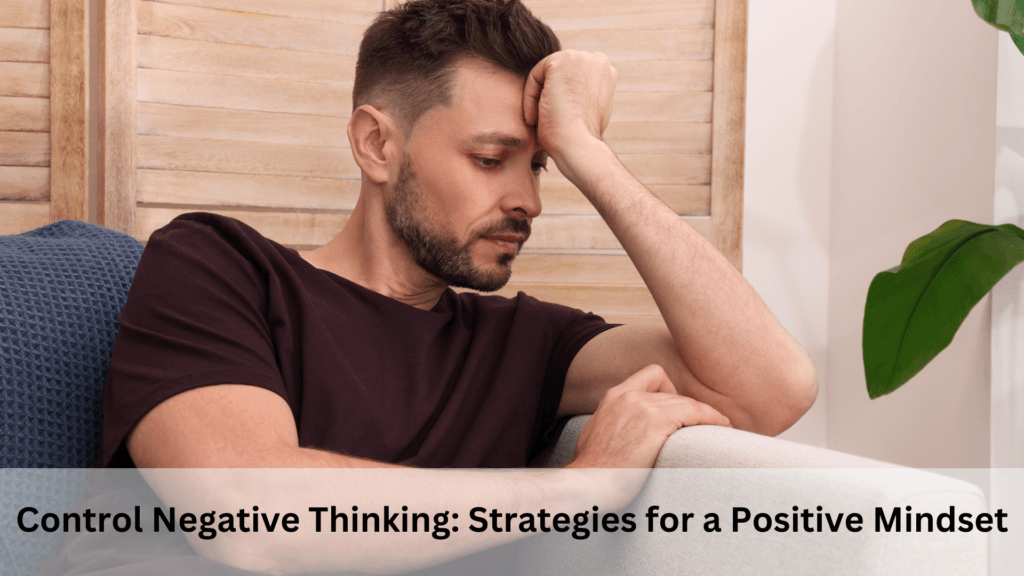It was a warm, sunny winter day when I was sitting and reading my favorite book with my close friend. It talked about a person whose mental health was impacted terribly because of poor thought management. Suddenly, my friend said, ‘Did you know the average person has around 12,000–60,000 thoughts daily, with 80% being negative? I said, I know that but haven’t really given it a thought. That moment of sudden realization made me determined to find out what was really going on and what we could do about it. As a researcher at heart and in the field of psychology, this thing made me focus on new perspectives and insights.
To truly understand the impact of these thoughts, we must explore the nature of negative thinking and its roots. In this article, we’ll examine common cognitive distortions, their biological and environmental influences, and practical strategies to control negative thinking and cultivate a more positive mindset.

Understanding Negative Thinking
Most of us have experienced negative thinking at some point. Mostly it concerns cognitive distortions or irrational ways of thinking that bring people down. Knowledge about those distortions helps get rid of them. So let’s break this down to some of the common ones.
- Catastrophizing: That means that you would expect to get the worst thing that may happen in every situation. So if a big test is coming up, then you begin to think, “If I don’t ace this test, my whole future is ruined!” That kind of thinking can build up a lot of undue stress and anxiety.
- Personalization: This distortion is characterized by the belief that everything is your fault. When anything goes wrong at work or school, you may believe that you are solely to blame. When there is no explanation, this causes humiliation and guilt.
- Emotional Reasoning: You believe your feelings to be accurate. Because of this, you might believe that going to a social event will be a terrible experience if you are worried about it. Feelings are not facts, however.
Other common distortions include all-or-nothing thinking or seeing everything as either perfect or terrible; overgeneralization by drawing a broad conclusion through a single event; and mental filtering, where you’re able to see only the negative and not the good.
Quick Reference Chart
To make it easier to detect these cognitive distortions, here is a quick chart:
| Cognitive Distortion | Explanation |
| All-or-Nothing Thinking | Seeing things as absolutely perfect or absolutely terrible. |
| Overgeneralization | Broadly concluding based on only one event. |
| Mental Filter | Pay no attention to the good and let the bad consume you. |
| Disqualifying the Good | Putting aside pleasant experiences as irrelevant. |
| Jumping to Conclusions | Jumping to conclusions with no evidence. |
| Mind Reading | Assuming you know what other people think. |
| Fortune Telling | Predicting, of course, that things are going to go badly. |
| Magnification | Making things bigger than they really are. |
| Should Statements | Demands on yourself or others. |
| Labeling | Labeling oneself or others for a mistake. |
You may ask why we so often think of things badly. And that answer lies both in biology and the environment.
- Biological Perspective: Our brains have been programmed to focus more on threats than not as a survival tactic from our ancestors, who needed to remain constantly alert to survive in this cutthroat world. It simply indicates that the human brain is predisposed to focus more on negative experiences than positive ones.
- Environmental Factors: Our environment too contributes to our thought process. For example, you might have grown up in an environment where people always criticize or always use negative words with people who might reflect upon your mind and your abilities.
Quick Self-Assessment
To begin to develop a sense of some of your own patterns of negative thought, ask yourself these questions:
- Do you ever catch yourself thinking, “I’m a failure” when you mess something up?
- Do you assume the worst in challenging situations or blame yourself unnecessarily?
Knowing about these patterns is the first step to positive change!
How to Break Free of Negative Thinking
Now that we understand what negative thinking is and why it happens, let’s discuss a few good strategies to shift our minds into a positive thinking perspective:
Know Your Negative Thoughts
Knowing your thoughts is the first step to managing them. Very helpful here is journaling. Write down as many of your thoughts as can come along, especially during sad and anxious moments.
Example Template
Use this simple template to track thoughts:
| Date | Negative Thought | Trigger | Distortion | Reframe |
| 2024-12-16 | “I always fail.” | Critical feedback | All-or-Nothing | “I can learn from this.” |
| 2024-12-17 | “No one likes me.” | Social gathering | Catastrophizing | “Some people enjoy my company.” |
| 2024-12-18 | “I’ll never be happy again.” | After breakup | Fortune Telling | “I can have fun with new things.” |
With the negative thoughts and their triggers, you will see patterns you can work to change.
Challenge Negative Thoughts
Once you have identified your negative thoughts, challenge them! Ask yourself:
- Is this thought fact-based?
- What evidence does it contradict?
For example, if your thought is “I am really bad at math,” remember when you did well or when teachers and friends complimented you. Try to replace the negative thought with some more realistic alternatives that reflect your reality.
Practice Gratitude and Self-Compassion
Actually, gratitude practice can be very uplifting for one’s mood. Take out a gratitude journal every day and write down three good things that happened; however minor they may seem, it’s worth writing down, such as enjoying a great meal or talking to a friend.
Self-compassion is just as important. Treat yourself nicely when things are not going well—just like you would to a good friend who’s having a bad day. Remember, everybody screws up and has bad days—it’s human nature!
Mindfulness and Meditation
Being mindful is paying attention to your ideas without passing judgment and living in the present. It’s about paying attention to what’s going on both within and outside of you without getting sucked into the action. Deep breathing techniques or mindfulness applications like Calm or Headspace can be used to cultivate mindfulness.
Another good technique is repeating positive affirmations—simple statements that reinforce positive beliefs about yourself. Write these affirmations on sticky notes and place them where you’ll see them often—like on your bathroom mirror or computer screen!
Reduce Negative Influences
Look at your environment and try to reduce exposure to negativity. This may mean avoiding toxic relationships or limiting time spent on social media platforms filled with bad news.
Be in your vicinity with positivity! Create inspiring stories within your social media feeds—follow people who inspire, motivate, and encourage you. Surround yourself with happy times with people who uplift, support, and encourage.
Movement
There could have been such occurrences where people practiced yoga, danced, or walked, and their moods were considerably enhanced.
Exercise releases endorphins, feel-good hormones that help relieve tension and anxiety. Not only that, but moving also gets your mind clear, providing you with a clean perspective!
Build Resilience
Building resilience means learning the art of bouncing back with greater strength than before. Reflect back on past failures and learn what lessons they taught. Building small achievable goal steps can also help build a person’s confidence over time.
Celebrate every little victory along the way! It could be getting a work task done or getting out of bed on a tough day.
These all help strengthen positive thinking patterns.
Personalized Strategies
Everyone controls negative thoughts differently. Here are some personalized strategies for various groups:
- For Professionals: If you have imposter syndrome—you feel like you are less capable than everyone thinks you are—look to mindfulness practices that will get you out of your head and back into the present. Break tasks into smaller steps so that they’re not overwhelming. Celebrate victories as soon as they come!
- For Parents: Use affirmations like “I’m doing my best for my child/children” regularly with your children to foster your self-esteem. Practicing mindfulness together can create bonding moments while teaching valuable skills.
- For Teens: Building self-esteem during adolescence can be challenging but crucial. Foster supportive friendships by surrounding yourself with positive influences. Gratitude journaling can also help shift focus away from insecurities toward appreciation for what’s good in life.
Conclusion
As I reflect on my journey through understanding negative thoughts sparked by that insightful book discussion with my friend, it’s clear that negative thinking is one of the hardest things to deal with—but all of us have experienced it at some point in our lives. However, by adopting such strategies as cognitive restructuring, mindfulness practices, gratitude exercises, and learning how to control negative thinking, we can make our mindset something positive.
Remember, change does not happen overnight. Start small by implementing one or two changes in your daily life and progress from there. Stay consistent and keep an open mind; embrace the positive vibes! Every step is working toward a happier life that is full of joy and fulfillment.
This is just all about balance really—you are aware that you are thinking this but don’t want that definition of you; you’re really in control of controlling negative thinking and altering their direction in healthier ways. Visit our blog to better understand how to take care of your mental health. Let your mental well-being shine!



